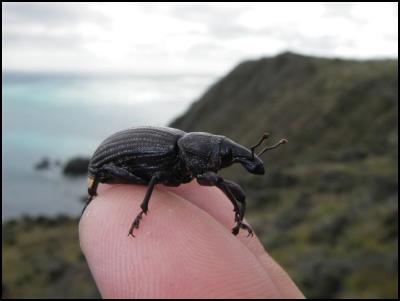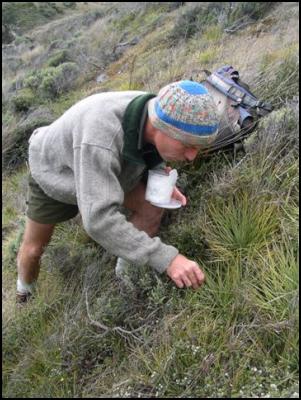Weevil rescue underway
31 March 2006
Weevil rescue underway

A rescue mission has been mounted for a population of weevils living on a knife edge on Wellington’s south coast.
Department of Conservation staff and volunteers are risking a slashing from the sharp, blade-like leaves of the native plant speargrass to retrieve large flightless weevils that depend on the plant for their survival. Under threat from introduced mammals and habitat modification and in danger of extinction, this only North Island population of speargrass weevils (Lyperobius huttoni) is being transferred to the safety of predator-free Mana Island.

Seven weevils were taken to Mana Island this week as DOC implements a plan to move up to 30 weevils from the south coast to the island, where there is an abundance of speargrass as well as climatic conditions which match those on the south coast. It is hoped they will establish a self-sustaining population there so Wellingtonians won’t lose what is probably their most locally rare and endangered native animal.
DOC Poneke biodiversity ranger Andrew Morrison said most speargrass weevils were found in the South Island, on the eastern side of the Southern Alps.
“In the North Island they are restricted to this one small population which is also New Zealand’s only coastal population of the species”
Speargrass (Aciphylla species) is an alpine species, but it grows along Wellington’s south coast and on Mana Island because the dynamic environment of Cook Strait is similar to the alpine environment. Speargrass weevils live and feed exclusively on the plant. The adults, which grow up to 2 cm long, feed on the leaves and shelter in the leaf litter under the plant, while the larvae develop in the soil, feeding on the speargrass roots. They live for three years, one as a larva and two years as an adult.
“There are probably not many people aware of these cryptic little creatures in Wellington, but they are an important part of our biodiversity and they are threatened with extinction,” Mr Morrison said.
“Mice and rats prey on the weevils and wild goats and pigs destroy the speargrass plants.”
Attempts have been made to fence off areas of speargrass plants, kill the mice and rats with poison baits, and replant new areas of speargrass but the weevil population had continued to decline, he said.
“Studies have estimated their numbers to have dropped to around 150 individuals so it’s vital that we move them from the vulnerable south coast location to a secure site where their numbers can increase.”
Work will continue to restore the south coast site so one day the weevils can be returned to their original habitat.
Meanwhile they are expected to thrive on Mana Island, alongside species introduced to the island as part of a long term plan to restore its natural ecology. Friends of Mana Island (FOMI), which is behind the restoration project, has committed more than $1000 in funding and volunteer support toward the weevil transfer.
“We are pleased that yet another creature is able to take advantage of all the work being undertaken on Mana Island over the years to make it a safe refuge for a variety of endangered flora and fauna,” FOMI president Brian Paget said.
Takahe, North Island robin, brown teal, diving petrels, fairy prion, fluttering shearwater, yellow-crowned kakariki, speckled and spotted skinks, Wellington green geckos and flax weevils have also been transferred to the island. A wetland has been restored and hundreds of thousands of native trees have been planted by volunteers.
ENDS


 Transpower: Major Electricity Development For Western Bay Of Plenty A Step Closer
Transpower: Major Electricity Development For Western Bay Of Plenty A Step Closer Alcohol Beverages Council: Turning The Tide - New Zealanders Unite To Curb Harmful Drinking
Alcohol Beverages Council: Turning The Tide - New Zealanders Unite To Curb Harmful Drinking University of Auckland Business School: Economists Urge Action To Prevent ‘AI Poverty Traps’
University of Auckland Business School: Economists Urge Action To Prevent ‘AI Poverty Traps’ Bill Bennett: Australian warship takes rural fixed wireless broadband offline
Bill Bennett: Australian warship takes rural fixed wireless broadband offline NZ Telecommunications Forum - TCF: New Zealand Is Saying Goodbye To 3G: Are You Ready For The Change?
NZ Telecommunications Forum - TCF: New Zealand Is Saying Goodbye To 3G: Are You Ready For The Change? NZ Post: Mānawatia A Matariki - NZ Post Stamps Look To The Stars Ahead Of The Māori New Year
NZ Post: Mānawatia A Matariki - NZ Post Stamps Look To The Stars Ahead Of The Māori New Year


